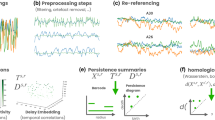Abstract
One of the cutting-edge methods for analyzing large sets of data involves looking at their “shape”, namely their geometry and topology. In this paper, we apply topological analysis to data arising from a neuroscience experiment involving multichannel voltage measurements of brain activity in awake rats. Data points are viewed as a point cloud, with distance defined using channel correlations or a Euclidean metric. Exploratory data analysis reveals that the topological structure defined in terms of a Euclidean metric can distinguish between a coherent oscillatory brain state and the desynchronized awake state, by associating different Betti numbers to the different brain states.
Access this chapter
Tax calculation will be finalised at checkout
Purchases are for personal use only
Similar content being viewed by others
References
Carlsson, G.: Topology and data. Bull. Am. Math. Soc. 46, 255–308 (2009)
Curto, C.: What can topology tell us about the neural code? Bull. Am. Math. Soc. 54, 63–78 (2016)
Edelsbrunner, H., Harer, J.: Computational Topology: An Introduction. American Mathematical Society, Providence (2009)
Fontanini, A., Katz, D.B.: 7 to 12 Hz activity in rat gustatory cortex reflects disengagement from a fluid self-administration task. J. Neurophysiol. 93, 2832–2840 (2005)
Hatcher, A.: Algebraic Topology. Cambridge University Press, Cambridge (2001)
Imada, A., Morris, A., Wiest, M.: Deviance detection by a P3-like response in rat posterior parietal cortex. Front. Integr. Neurosci. 6, 127 (2013)
Khalid, A., Kim, B.S., Chung, M.K., Ye, J.C., Jeon, D.: Tracing the evolution of multi-scale functional networks in a mouse model of depression using persistent brain network homology. NeuroImage. 101, 351–363 (2014)
Munkres, J.: Topology, 2nd edn. Pearson, London (2000)
Nicolelis, M.A., Baccala, L.A., Lin, R.C., Chapin, J.K.: Sensorimotor encoding by synchronous neural ensemble activity at multiple levels of the somatosensory system. Science 268, 1353–1358 (1995)
Nicolelis, M.A., Fanselow, E.E.: Thalamocortical [correction of Thalamcortical] optimization of tactile processing according to behavioral state. Nat. Neurosci. 5, 517–523 (2002)
Polack, P.O., Charpier, S.: Intracellular activity of cortical and thalamic neurons during high-voltage rhythmic spike discharge in Long-Evans rats in vivo. J. Physiol. 571, 461–476 (2006)
Rodgers, K.M., Dudek, F.E., Barth, D.S.: Progressive, seizure-like, spike-wave discharges are common in both injured and uninjured sprague-dawley rats: implications for the fluid percussion injury model of post-traumatic epilepsy. J. Neurosci. 35, 9194–9204 (2015)
Shaw, F.Z.: 7–12 Hz high-voltage rhythmic spike discharges in rats evaluated by antiepileptic drugs and flicker stimulation. J. Neurophysiol. 97, 238–247 (2007)
Tausz, A., Vejdemo-Johansson, M., Adams, H.: JavaPlex: a research software package for persistent (Co)homology. Software (2011). http://code.google.com/javaplex
Vergnes, M., Marescaux, C., Depaulis, A., Micheletti, G., Warter, J.M.: Spontaneous spike and wave discharges in thalamus and cortex in a rat model of genetic petit mal-like seizures. Exp. Neurol. 96, 127–136 (1987)
Wiest, M.C., Nicolelis, M.A.: Behavioral detection of tactile stimuli during 7–12 Hz cortical oscillations in awake rats. Nat. Neurosci. 6, 913–914 (2003)
Acknowledgments
The authors would like to thank the Wellesley College Science Center Summer Research Program and the Brachman-Hoffman Fellowship. Ismar Volić would also like to thank the Simons Foundation for its support. Michael Wiest’s work was supported by National Science Foundation Integrative Organismal Systems grants 1121689 and 1353571.
Author information
Authors and Affiliations
Corresponding author
Editor information
Editors and Affiliations
Rights and permissions
Copyright information
© 2019 Springer Nature Switzerland AG
About this paper
Cite this paper
Ju, N., Volić, I., Wiest, M. (2019). Detecting Functional States of the Rat Brain with Topological Data Analysis. In: Avdaković, S. (eds) Advanced Technologies, Systems, and Applications III. IAT 2018. Lecture Notes in Networks and Systems, vol 59. Springer, Cham. https://doi.org/10.1007/978-3-030-02574-8_1
Download citation
DOI: https://doi.org/10.1007/978-3-030-02574-8_1
Published:
Publisher Name: Springer, Cham
Print ISBN: 978-3-030-02573-1
Online ISBN: 978-3-030-02574-8
eBook Packages: Intelligent Technologies and RoboticsIntelligent Technologies and Robotics (R0)




